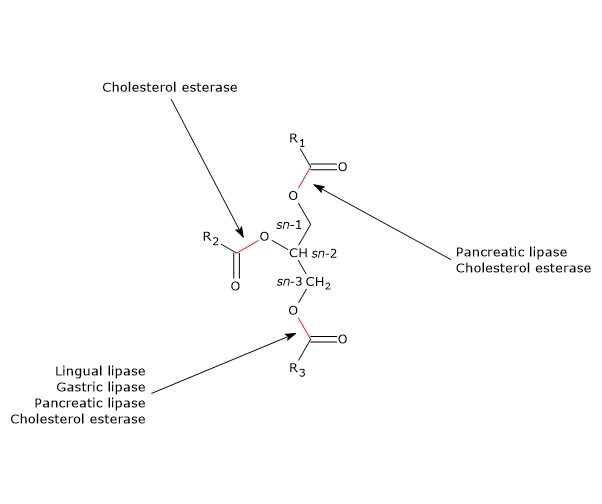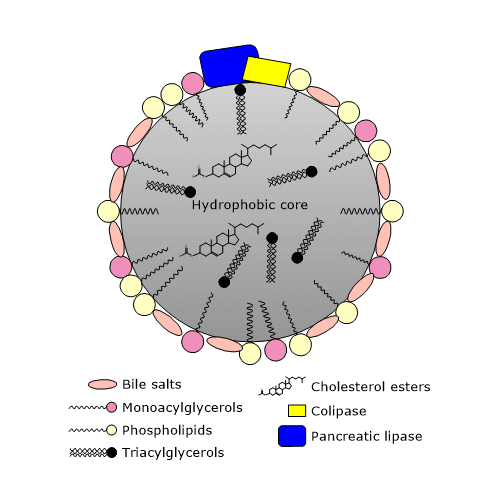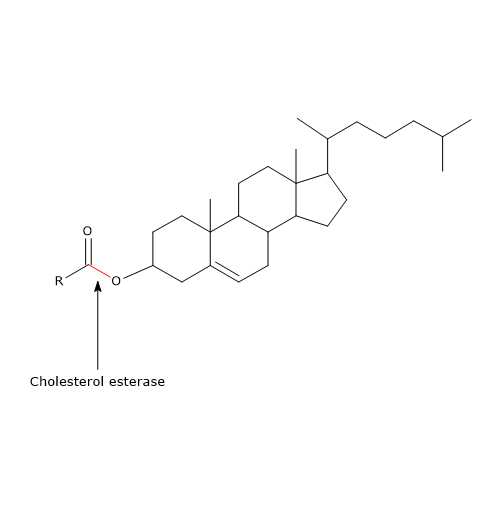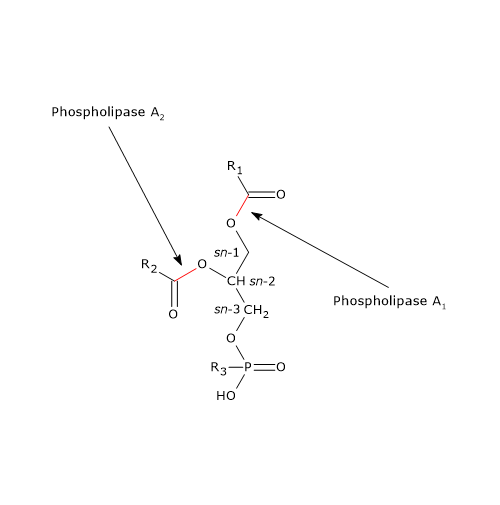Lipid digestion and lipid absorption are complex processes. They involve soluble enzymes, substrates with different degree of solubility, and occur primarily in the stomach and small intestine.
Dietary lipids are triglycerides, phospholipids, steroids, especially cholesterol and cholesterol esters, fat-soluble vitamins, namely, vitamin A, D, E and K, and carotenoids.
Lipids may be solid or liquid at room temperature and are referred to as fats and oils, respectively.
- Triglycerides or triacylglycerols account for about 90 percent of dietary lipids. They consist of one glycerol molecule esterified to three fatty acids, mostly long chain fatty acids (16-20 carbon atoms). They have an energy density more than twice that of carbohydrates (about 9 kcal/g vs. about 3.75) and amino acids. They must release their fatty acids to be used as a source of energy.
- Phospholipids, the main constituents of biological membranes, consist of one glycerol molecule esterified with two fatty acids at the sn-1 and sn-2 positions, and a phosphoric acid at the sn-3 position. In turn, the phosphate group binds a hydrophilic group, such as choline, serine or inositol, via ester bond. The daily intake of phospholipids is low, 1-2 g; however, also biliary phospholipids pour into the small intestine, about 10-20 g per day, mostly phosphatidylcholine.
- Cholesterol and its esters, together with small amounts of steroid hormones, are found only in animal products, unlike the lipids seen up to now which are also found in plant products.
In the small intestine, in addition to dietary cholesterol, which should not exceed 300 mg per day, there is also biliary cholesterol, about 1 g per day. Both dietary and biliary cholesterol are mostly in non-esterified form, about 85-90 percent, the only form of cholesterol that can be absorbed in the small intestine.
Like vitamins, even this steroid molecule is not a source of energy.
A variety of plant stanols and sterols, in particular the beta-sitosterol, which is not absorbed under physiological conditions, are also included among dietary steroids.
Despite scientific societies recommend a lipid intake, basically triacylglycerols, not exceeding 30 percent of the daily caloric intake, in Western diet, fats and oils provide between 30 to 45 percent of the daily caloric intake.
Hydrophobicity, one of the distinctive properties of many dietary lipids, that makes triglycerides excellent molecules for energy storage, creates problems when such molecules are digested in the gastrointestinal tract, absorbed in the small intestine, and finally transported in the circulation after absorption or mobilization from body stores.
Indeed, lipids such as triglycerides with long chain fatty acids, and cholesterol and fat-soluble vitamin esters are extremely hydrophobic, and aggregate into large droplets in the stomach and small intestine. These droplets will then be emulsified in order to allow hydrolases to catalyze lipid digestion.
Contents
Steps, enzymes, and products
Lipid digestion begins in the mouth, continues in the stomach, and ends in the small intestine.
Enzymes involved in triacylglycerol digestion are called lipase (EC 3.1.1.3).
They are proteins that catalyze the partial hydrolysis of triglycerides into a mixture of free fatty acids and acylglycerols. There are several lipases, the most important of which is produced by the exocrine pancreas. The others are lingual lipase, gastric lipase, and breast milk lipase.

Other enzymes involved in lipid digestion are cholesterol esterase and phospholipases A1 and A2.
Lipid digestion and lingual lipase
In the mouth, food is broken into small particles and mixed with lingual lipase.
The enzyme is produced and secreted by serous lingual glands, also called von Ebner’s glands.
It is stable in an acid environment, and therefore remains active in the stomach, and also in the small intestine when there is no proper pancreatic secretion of bicarbonate.
The reaction catalyzed by ligual lipase releases a single fatty acid, preferably a short-chain fatty acid, such as butyric acid, or a medium-chain fatty acid, such as caproic acid, caprylic acid, capric acid, and lauric acid, and a 1,2-diacylglycerol, which is then hydrolyzed in the duodenum.
Note: short-chain fatty acids are mainly esterified in sn-3 position of the triacylglycerol.
Lingual lipase plays a modest role in the digestion of triacylglycerols, since:
- it has a slower activity than pancreatic lipase;
- it acts in the stomach, an aqueous environment in which the lipids tend to coalesce, forming a separate phase from the surrounding environment, thus limiting the opportunities for the enzyme to hydrolyze triacylglycerols.
Lingual lipase activity is not particularly important for healthy adults. On the contrary, it is very important for infants, in which pancreatic lipase is still immature, also advantaged by the fact that milk triglycerides are rich in short-chain and medium-chain fatty acids. Moreover, like gastric lipase, it is able to penetrate into the fat globules of the milk, thereby initiating the digestive process, whereas pancreatic lipase is not able to penetrate into these fat globules.
Obviously, the action of this enzyme is important also when pancreatic lipase is absent.
As the tongue is sensitive to the taste of free fatty acids, especially polyunsaturated ones, rather than of triglycerides, lingual lipase activity could play a role in detecting fatty foods as a source of energy, and therefore influence food choices.
Finally, the release of short-chain and medium-chain fatty acids and diacylglycerols is important also because they are amphipathic molecules, that is, they have an hydrophilic region, which interacts with the surrounding aqueous phase, and a hydrophobic region, which is orientated towards the core of the lipid droplets. Due to the action of these surfactants, fat droplets obtain a hydrophilic surface, that is, a stable interface with the surrounding aqueous phase. This, together with the churning action of the stomach, leads to the formation of an emulsion of droplets, which decrease in size. The emulsion will then be released into the duodenum as chyme. Other amphipathic molecules present in food are lecithin and phospholipids, and all together, they allow to increase the surface area available for hydrolase activity.
In the stomach, lipids are mixed also with gastric juice and hydrochloric acid. The acid also denatures the proteins of the lipid-protein complexes; the polypeptides are then digested by gastric proteases, and the lipids are released.
Lipid digestion and gastric lipase
In the stomach, lipids are hydrolyzed also by a second acid lipase, the gastric lipase.
This enzyme is secreted by the chief cells of the gastric mucosa.
It has an optimal pH around 4, but is still quite active at less acidic pH values, 6 to 6.5. Therefore, it probably remains active even in the upper duodenum, where the pH is between 6 and 7.
The enzyme preferentially catalyzes the hydrolysis of triglycerides with short-chain fatty acids and medium-chain fatty acids, but may also hydrolyze long-chain fatty acids. Regardless of the type of fatty acids, gastric lipase preferentially cleaves those at the sn-3 position, leading to the release of a free fatty acid and a 1,2-diacylglycerol, molecules that can act as surfactants, as previously seen.
Like lingual lipase, it is particularly active on triglyceride of milk, also of breast milk, which are rich in short-chain and medium-chain fatty acids. Moreover, it is also active on triacylglycerols of some tropical oils, e.g. coconut oil, which are rich in medium-chain fatty acids.
The enzyme can account for 10 to 30 percent of triacylglycerol hydrolysis occurring in the gastrointestinal tract, and up to 50 percent in breast-fed infants.
Bile salts and the emulsion of lipid droplets
The chyme, containing a lipid emulsion made up of droplets of diameter less than 0.5 mm, enters the upper portion of the small intestine, the duodenum, where the hydrolysis of triglycerides continues.

In the duodenum, the chyme is mixed with bile, whose release by the gallbladder is stimulated by cholecystokinin, hormone secreted by cells of the mucosa of the duodenum and jejunum in response to the ingestion of a meal, particularly if high in fat.
In the bile, among the other components, there are bile salts, phospholipids, and cholesterol. Bile salts are bile acids conjugated with glycine or taurine. In turn, bile acids are oxygenated derivatives of cholesterol. Bile acids and bile salts are both synthesized by the liver. They are amphipathic molecules, in whose planar ring structure you can identify a hydrophobic face and a hydrophilic face. Therefore, they are able to further emulsify lipid droplets, increasing the surface area for hydrolase activity.
In particular, salts of cholic acid, which contain three hydroxyl groups, are better emulsifiers than salts of deoxycholic acid, which instead contain only two hydroxyl groups.
Note: the gallbladder secretes about 30 g of bile salts each day, together with phospholipids and cholesterol. Most of the bile salts and cholesterol is then reabsorbed, so that the daily fecal loss of bile salts and steroids is quite low, 0.2-1 g.
The mechanism of peristalsis and the surfactants seen so far, taht is, free fatty acids, acylglycerols, phospholipids, and bile salts, ensure the formation of microscopic micelles, which further increase the available surface areas for hydrolytic enzyme activities.
It should be underlined that triacylglycerols with short-chain and medium-chain fatty acids can be both hydrolyzed and absorbed in the absence of bile salts, although their presence increases the absorption.
Lipid digestion and pancreatic lipase
Cholecystokinin also stimulates the exocrine pancreas to secrete a pancreatic juice containing, among other molecules, pancreatic lipase.
The enzyme catalyzes the digestion of the majority of ingested triglycerides, mainly in the upper portion of the jejunum.
It has a optimum pH of 7.0 to 8.8. Therefore it is not an acid lipase, as lingual and gastric lipases.
PAncreatic lipase catalyzes the cleavage of fatty acids, typically with 10 or more carbon atoms, primarily in sn-1 and sn-3 positions of the glycerol backbone. The products of the reaction are free fatty acids and 2-monoacylglycerols.
2-Monoacylglycerol, the primary form in which the monoacylglycerols are absorbed from the small intestine, can undergo an isomerization process in which the remaining fatty acid shifts to carbon 1 or 3. However, the rate of isomerization is slower than the rate of uptake of the molecule from the small intestine.
In vitro, pancreatic lipase is inhibited by bile salts, whereas in vivo, it hydrolyzes triglycerides in a very efficient manner, due to the presence of a protein cofactor secreted by exocrine pancreas, the colipase. This protein has no catalytic activity, is produced in inactive form, called procolipase, and is activated by trypsin in the duodenum. Lipid droplets are coated with phospholipids and bile salts, that give them a negative charge which prevents the binding of lipase, but attracts the colipase. In turn, colipase binds pancreatic lipase (lipase and colipase bind in a 1:1 molar ratio), thus anchoring the enzyme to the water-lipid interface of the lipid droplets.
Lipid digestion and lipase in breast milk
This lipase has a neutral pH optimum, and is stimulated by bile salts. The enzyme contributes substantially to hydrolysis of the triglycerides in the intestine of breast-fed infants.
Instead, there are no lipases in cow’s milk.
Lipid digestion and cholesterol esterase
Another enzyme present in the pancreatic juice is cholesterol esterase (EC 3.1.1.13). The enzyme, synthesized and secreted in an active form by the exocrine pancreas, is a lipase with broad specificity, being active on:
- cholesterol esters, with cholesterol and free fatty acids as reaction products;
- triglycerides, in which it hydrolyzes all the three ester bonds, and for this reason, it is also called non-specific esterase (it hydrolyzes 10-15 percent of the dietary triglycerides;
- monoacylglycerols;
- phospholipids;
- esters of vitamins A and D.

Like phospholipase A2, it is primarily active on cholesterol esters incorporated into bile salt micelles. Unlike pancreatic lipase, its activity is stimulated by bile salts, mainly trihydroxy salts, such as sodium taurocholate and glycocholate. These salts induce a protein conformational change that activates the enzyme. Moreover, trihydroxy salts promote its self-association into polymeric aggregates, which protect it from the action of proteases in the intestinal lumen.
Lipid digestion and phospholipases
The digestion of phospholipids is carried out by phospholipases, primarily phospholipase A2 (EC 3.1.1.4). The enzyme is present in the pancreatic juice in the form of a zymogen, called prophospholipases A2, and is activated by trypsin , enzyme involved in protein digestion.
Phospholipase A2 catalyzes specifically the cleavage of the fatty acid at the sn-2 position of the phospholipids, whereas it has a broad specificity with respect to both the length of the carbon chain of the target fatty acid and the polar head groups of the phospholipids.

Most of the phospholipids in the intestinal lumen are of biliary origin, and only a small fraction derives from diet.
Phospholipids in bile form micelles with cholesterol and bile salts. In the intestinal lumen, they are distributed between lipid droplets and these micelles, with a preference for the latter. Within the micelles, phospholipids, primarily phosphatidylcholine, serve as a substrate. Specifically, phosphatidylcholine undergoes a reaction producing a free fatty acid and lysophosphatidylcholine, a lysophospholipid.
Pancreatic juice contains phospholipase A1 as well, which removes the fatty acid at the sn-1 position of the phospholipid.
In the intestinal mucosa, there seems to be a third, modest, phospholipase activity, thanks to an intrinsic membrane enzyme. This enzyme is called phospholipase B or retinyl ester hydrolase, being active also on vitamin A esters.
The digestion of phospholipids can ends with the formation of a free fatty acid and a lysophospholipid or can be complete.
References
- Bender D.A. Introduction to nutrition and metabolism. 3rd Edition. Taylor & Francis, 2004
- Berdanier C.D., Dwyer J., Feldman E.B. Handbook of nutrition and food. 2th Edition. CRC Press. Taylor & Francis Group, 2007
- Chow Ching K. “Fatty acids in foods and their health implication” 3th Edition. CRC Press Taylor & Francis Group, 2008
- Hamosh M. Lingual and gastric lipases. Nutrition 1990;6(6):421-8.
- Iqbal J. and Hussain M.M. Intestinal lipid absorption. Am J Physiol Endocrinol Metab 2009;296:E1183-1194. doi:10.1152/ajpendo.90899.2008
- Nelson D.L., Cox M.M. Lehninger. Principles of biochemistry. 6th Edition. W.H. Freeman and Company, 2012
- Rosenthal M.D., Glew R.H. Medical Biochemistry – Human Metabolism in Health and Disease. John Wiley J. & Sons, Inc., Publication, 2009
- Stipanuk M.H., Caudill M.A. Biochemical, physiological, and molecular aspects of human nutrition. 3rd Edition. Elsevier health sciences, 2012